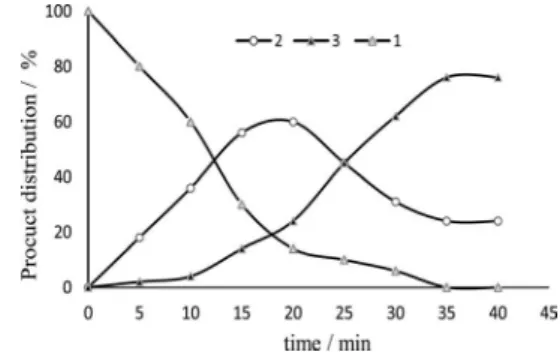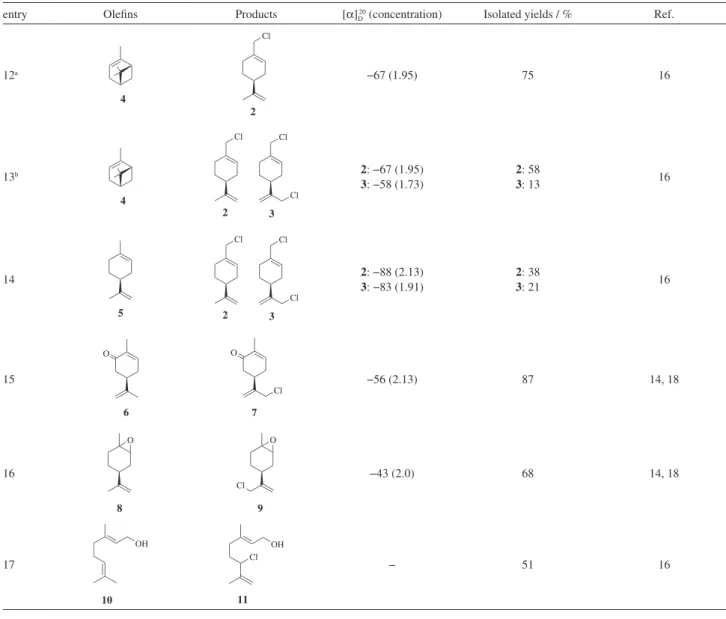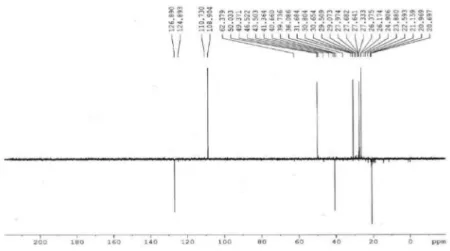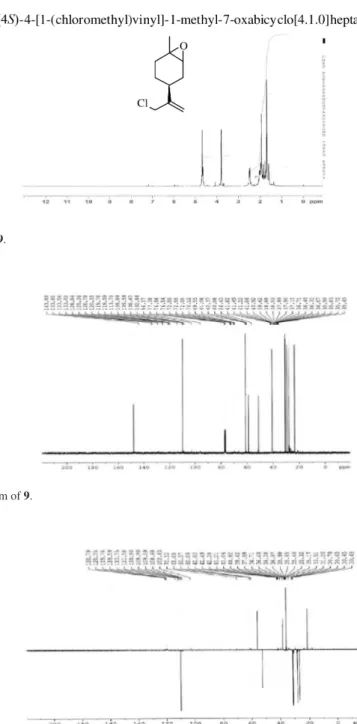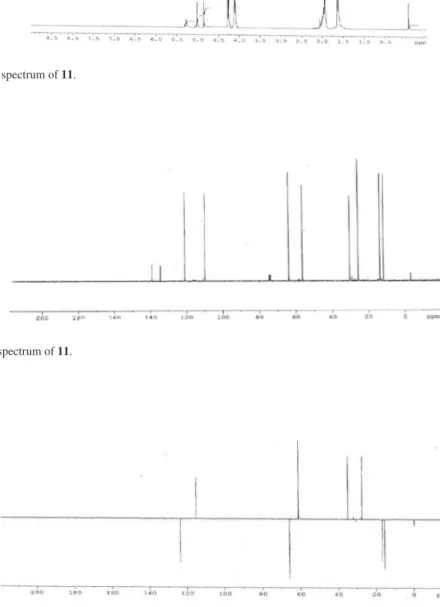Article
J. Braz. Chem. Soc., Vol. 22, No. 7, 1259-1262, 2011. Printed in Brazil - ©2011 Sociedade Brasileira de Química
0103 - 5053 $6.00+0.00
A
*e-mail: elirdoussi@ucam.ac.ma
Allylic Chlorination of Terpenic Oleins using a Combination of MoCl
5and NaOCl
Brahim Boualy, Larbi El Firdoussi,* Mustapha Ait Ali and Abdellah Karim
Laboratoire de Chimie de Coordination, Département de Chimie, Faculté des Sciences Semlalia, Université Cadi Ayyad, PB 2390, 40000 Marrakech, Morocco
MoCl5 é usado como eiciente agente na cloração alílica de oleinas terpênicas na presença
de NaOCl como doador de cloro. Vários terpenóides são convertidos aos cloretos de alila correspondentes em moderados a bons rendimentos em condições reacionais brandas e otimizadas. Diferentes precursores de molibdênio são estudados. Dentre eles, MoO3 fornece bom rendimento,
mas depois de um tempo de reação maior.
MoCl5 is applied as eficient agent in allylic chlorination of terpenic oleins in the presence
of NaOCl as chlorine donor. Various terpenes are converted to the corresponding allylic chlorides in moderate to good yield under mild and optimized reaction conditions. Different molybdenum precursors are also studied. Among them, MoO3 gives good yield, but after a longer reaction time.
Keywords: monoterpenes, allylic chlorination, molybdenum, sodium hypochlorite
Introduction
Allylic chlorinated terpenes represent a sustainable supply of intermediates for several segments of the ine chemical industry, e.g., the manufacture of lavors and fragrances.1-4 Previously, we have reported that allylic amines, alcohols, ketones and alkoxycarbonyl derivatives can be obtained in good yields by the metal complex catalyzed amination, oxidation and alkoxycarbonylation of some monoterpenes.5-7 Chlorination represents a valuable pathway to produce versatile starting materials that are widely used in synthetic organic chemistry.8-11 Chloride compounds can be prepared directly by bubbling molecular chlorine, but the dificulty of handling chlorine gas limits this procedure.12 Other authors have shown a convenient method for this transformation using solid CO2 and calcium hypochlorite13,14 or a combination of Vilsmeier reagent and H2O2.
15 However, this procedure is limited to non
acid-sensitive substrates.15 CeCl
3 or InCl3 combined with NaOCl have been reported as eficient systems for allylic chlorination of terminal oleins.12-16
In line with our continuous interest in the functionalization of natural terpenic oleins,5-7 we report here the result of our investigation on the allylic chlorination using a combination of sodium hypochlorite and molybdenum pentachloride.
Results and Discussion
In order to optimize the allylic chlorination of natural terpenes, β-pinene 1 was chosen as a model substrate (Scheme 1). The reaction was conducted irstly using various concentrations of MoCl5 in the presence of NaOCl at room temperature in different reaction times (Table 1).
To conirm the role of molybdenum pentachloride, a blank reaction was carried out under similar reaction conditions with β-pinene1as substrate. In the presence of NaOCl, no corresponding chlorinated product was observed even after stirring for a long reaction time (entry 1). The same result is observed when using MoCl5 without NaOCl (entry 2) even at high temperature (80 °C).As has been previously reported, chlorine is usually generated from
Cl Cl Cl
MoCl5/NaOCl
CH2Cl2/H2O
+ 2 (perillyl chloride) 3 (dichlorinated compound) 1
(β-pinene )
S c h e m e 1. Allylic chlorination of β-pinene promoted by
Allylic Chlorination of Terpenic Oleins using a Combination of MoCl5 and NaOCl J. Braz. Chem. Soc. 1260
sodium hypochlorite.12-16 This investigation shows clearly the role of MoCl5/NaOCl system in the activation and orientation of the reaction toward the desired product.
As it can be seen in Table 1, the stoichiometry of the reaction is also a key point. Using 0.5 equivalent of MoCl5, perillyl chloride 2 was obtained selectively in 67% yield after 30 min (entry 3). The replacement of MoCl5 by CeCl3 under similar reaction conditions gives the same product in only 32% yield. When it was used more than 0.5 equiv. of MoCl5, both mono- and dichlorinated compounds 2 and 3 were obtained with a variable ratio (entries 4 and 5). At higher amounts of MoCl5 (2 equiv.), the selectivity decreases considerably (entry 6).
It appears from these results that dichlorinated compound
3 formation is related to the use of high amount of MoCl5. In this context, Ceschi et al.16 have already shown that the conversion of β-pinene to the dichlorinated product was achieved using InCl3 or CeCl3 in a longer reaction time. Liu et al.17 has reported that both α-pinene and β-pinene led to quantitative formation of monochlorinated compounds in DMSO as solvent and phenyldichlorophosphate or phosphorus oxychloride as chlorine donor. It can be noted that the obtained compounds 2 and 3 are chiral with respective optical rotation [α]D
20 = −68 (1.96) and [α] D
20 = −62 (2.01)
in agreement with those reported in the literature.16 In order to gain a better insight on this point, a kinetic study was carried out with 1.5 equiv. of MoCl5 using GC (gas chromatography) to determine the conversion and product distribution (Figure 1). As depicted in Figure 1, the evolution of perillyl chloride 2 and 3versus time, shows that 2 was formed immediately. This compound reached a maximum after 20 min (62%) and then disappeared in favour of 3 whose amount, insigniicant at the early stage of the reaction, rapidly increased after 5 min and then much more slowly after 35 min. This observation proves that perillyl chloride 2 behaves, in the presence of an excess amount of MoCl5, as an intermediate that reacts to give
the dichlorinated 3, whereas it remains stable when using 0.5 equiv. of MoCl5.
A study of the inluence of the nature of the molybdenum precursor is reported in Table 2. Among the Mo compounds studied, MoCl5 appears the most suitable (entry 3). MoO3 gives good yield but only after a long reaction time (entry 7). In order to conirm the low activity of MoO3, other terpenes were checked, such as carvone and limonene with MoO3/NaOCl (0.5 equiv. of MoO3) under similar conditions. The reaction took place, although in low yields and after 24 h (30 and 19%, respectively). Other sources of Mo present very low activity (entries 9 and 10).
To assess the scope and limitation of this reaction, different monoterpenes were studied (Table 3). With MoCl5/NaOCl system under the optimized β-pinene conditions, all the substrates are converted to the corresponding chlorinated products in good to excellent yields.
α-Pinene 4 gave perillyl chloride 2 selectively (entry 12). However, both mono- and dichlorinated products 2 and 3 were obtained with the increasing of the amount of MoCl5 (1 equiv.) (entry 13). Entry 14 shows good conversion of limonene 5 to
Table 1. Allylic chlorination of β-pinene 1 with MoCl5/NaOCl
entry Equiv. of MoCl5
time / min
Conversiona /
%
Isolated yield / %
2 3
1 0 120 0 0 0
2b 0.5 120 0 0 0
3 0.5 30 87 67 0
4 1.0 30 89 62 13
5 1.5 30 93 28 58
6 2.0 15 100 Complex mixture
Conditions: β-pinene (0.5 mmol), NaOCl (2 mmol) in 20 mL of a mixture of CH2Cl2/H2O (1/1) at room temperature. aConversion is determined by
GC; breaction conducted without NaOCl.
Figure 1. Chlorination of β-pinene with MoCl5/NaOCl system; product
distribution vs. time determined by GC. Conditions: β-pinene (0.5 mmol), MoCl5 (0.75 mmol), NaOCl (2 mmol) in 20 mL of a mixture of CH2Cl2/H2O (1/1) at room temperature.
Table 2. Allylic chlorination of β-pinene by different sources of molybdenum
entry Lewis acid (equiv.)
time / h
Conversiona /
%
Isolated yield / %
3 MoCl5 (0.5) 0.5 87 67
7 MoO3 (0.5) 4 100 83
8 MoO3 (1) 2.5 100 78
9 C10H14MoO6 (1) 4 21 14
10 Mo(acac) 5 (1) 4 19 16
11 (NH4)6Mo7O24 (1) 24 0 0
the same products 2 and 3 in 38 and 21% yields, respectively. The difference of the optical rotation values of 2 and 3 obtained from the chlorination of pinenes and limonene is due to the fact that the ring opening of the pinenes can result in partial racemization. With carvone 6, limonene oxide 8 and geraniol
10, the reaction also works well to give the corresponding monochlorinated derivatives (entries 15-17).
Conclusions
In conclusion, we have described an efficient and facile method for the transformation of naturally occurring monoterpenes to the corresponding allylic chlorides using an inexpensive and readily available Lewis acid (MoCl5). The reaction processes in short reaction time, under mild
conditions to afford the expected products in moderate to good yields. A rearrangement of α-pinene and β-pinene to perillyl chloride is observed. Some other molybdenum precursors have been checked and interesting results have been obtained with MoO3/NaOCl and β-pinene as substrate. These results lead us to believe that this allylic chlorination method may represent a valuable alternative to the existing procedures reported in the literature.
Experimental
Instruments
NMR studies were performed on a Bruker Avance 300 spectrometer in CDCl3, chemical shifts are given in ppm Table 3. Allylic chlorination of natural terpenes by MoCl5/NaOCl
entry Oleins Products [α]D20 (concentration) Isolated yields / % Ref.
12a
2
Cl
−67 (1.95) 75 16
13b
Cl Cl
2 3
Cl
2: −67 (1.95)
3: −58 (1.73)
2: 58
3: 13 16
14
Cl Cl
2 3
Cl
2: −88 (2.13)
3: −83 (1.91)
2: 38
3: 21 16
15
6
O
7 O
Cl
−56 (2.13) 87 14, 18
16 −43 (2.0) 68 14, 18
17 − 51 16
Conditions: olein (0.5 mmol); MoCl5 (0.25 mmol); NaOCl (2 mmol) in 20 mL of a mixture of CH2Cl2/H2O (1/1); 30 min at room temperature. aReaction
Allylic Chlorination of Terpenic Oleins using a Combination of MoCl5 and NaOCl J. Braz. Chem. Soc. 1262
relative to external TMS (tetramethylsilane) and coupling constant (J) in Hz. Mass spectra were recorded on AMD 402 spectrometer (70 eV, EI). All the spectroscopic data of the known products were compared with those reported in the literature. The reaction mixtures were analyzed on a Trace GC Thermo Finnigan chromatograph equipped with an FID detector (flame ionization detector). GC parameters for capillary columns BP (25 m × 0.25 mm, SGE): injector 250 °C; detector 250 °C; oven 70 °C for 5 min then 3 °C min-1 until 250 °C for 30 min; column pressure 20 kPa, column low 6.3 mL min-1; linear velocity 53.1 cm s-1; total low 138 mL min-1. Optical rotations were measured in an ATAGO polax-D polarimeter with a 0.1 dm cell at a temperature of 20 °C. Liquid chromatography was performed on silica gel (Merk 60, 220-440 mesh; eluent: hexane). Analytical thin-layer chromatography (TLC) was conducted on Merck aluminium plates with 0.2 mm of silica gel 60F-254. All the reagents and solvents used in the experiments were purchased from commercial sources and used as received without further puriication (Aldrich, Acros).
General procedure
In a typical experiment, olein (0.5 mmol) in 10 mL of CH2Cl2 was added to a vigorously stirred solution of MoCl5 (0.25 mmol) in 10 mL of water. It was added 2 mmol (0.95 mL) of NaOCl (13% m/m) To the resulting mixture and the reaction mixture was stirred for 30 min at room temperature. The reaction was quenched by the slow addition of saturated aqueous Na2SO3. The layers were separated and the aqueous layer was extracted with CH2Cl2 (2 × 10 mL). The combined organic layer was dried over anhydrous Na2SO4. The solvent was removed under reduced pressure. Pure chlorinated products were obtained by column chromatography over silica gel (weight ratio of silica gel to compound mixture: 220/1) using hexane as eluent. All isolated pure products were fully characterized by 1H and 13C NMR and MS, and then compared with the known compounds.
Supplementary Information
Supplementary information (1H and 13C NMR and MS data for compounds 2, 3, 7, 9 and 11) is available free of charge at http://jbcs.org.br as a PDF ile.
References
1. Erman, W. E.; Chemistry of the Monoterpenes: An Encyclopedic Handbook, Marcel Dekker: New York, 1985; vol. 1, p. 832. 2. Botteghi, C.; Marchetti, M.; Paganelli, S. In Transition Metals
for Organic Synthesis; Beller, M.; Bolm, C., eds.; Wiley-VCH: Weinheim, 1998, vol. 1, p. 25.
3. Gusevskaya, E.V.; Quim. Nova 2003, 26, 242.
4. Chalk, A. J. In Catalysis of Organic Reactions; Rylander, P.N.; Greenield, H.; Augustine R.L., eds.; Marcel Dekker: New York, 1988, vol. 22, p. 43.
5. El Houssame, S.; Anane, H.; El Firdoussi, L.; Karim, A.; Cent. Eur. J. Chem. 2008, 6, 470.
6. AitAllal, B.; El Firdoussi, L.; Allaoud, S.; Karim, A.; Castanet, Y.; Mortreux, A.; J. Mol. Catal. A: Chem. 2003, 200, 177. 7. El Houssame, S.; El Firdoussi, L.; Allaoud, S.; Karim, A.;
Castanet, Y.; Mortreux, A.; J. Mol. Catal. A: Chem. 2001, 168, 15.
8. Groesbeek, M.; Smith, S. O.; J. Org. Chem. 1997, 62, 3638. 9. Brocksom, T. J.; Zanotto, P.R.; Brocksom, U.; Tetrahedron Lett.
2005, 46, 2397; Brocksom, T. J.; Santos, R. B.; Varanda, N. A.; Brocksom, U.; Synth. Commun. 1988, 18, 1403.
10. Pisoni, D. S.; Silva, D. B.; Schenato, R. A.; Ceschi, M. A.; J. Braz. Chem. Soc. 2004, 15, 652.
11. Easton, C. J.; Edwards, A. J.; McNabb, S. B.; Merrett, M. C.; O’Connell, J. L.; Simpson, G. W.; Simpson, J. S.; Willis, A. C.; Org. Biomol. Chem. 2003, 1, 2492.
12. Moreno-Dorado, F. J.; Guerra, F. M.; Manzano, F. L.; Aladro, F. J.; Jorge, Z. D.; Massanet, G. M.; Tetrahedron Lett. 2003, 44, 6691. 13. Hegde, S. G.; Vogel, M. K.; Saddler, J.; Hrinyo, T.; Rockwell, N.;
Haynes, R.; Olever, M.; Wolinsky, J.; Tetrahedron Lett. 1980, 21, 441.
14. Hegde, S. G.; Wolinsky, J.; J. Org. Chem. 1982, 47, 3148. 15. Xiong, Z. M.; Yang, J.; Li, Y. L.; Tetrahedron: Asymmetry 1996,
9, 2607.
16. Pisoni, D. S.; Gamba, D.; Fonseca, C. V.; da Costa, J. S.; Petzhold, C. L.; de Oliveira, E. R.; Ceschi, M. A.; J. Braz. Chem. Soc.
2006, 17, 321.
17. Liu, H. J.; Nyangulu, J. M.; Tetrahedron Lett. 1989, 30, 5097. 18. Matsuda, F.; Kito, M.; Sakai, T.; Okada, N.; Miyashita, M.;
Shirahama, H.; Tetrahedron 1999, 55, 14369.
Submitted: October 10, 2010
Supplementary Information
S
I
J. Braz. Chem. Soc., Vol. 22, No. 7, S1-S5, 2011. Printed in Brazil - ©2011 Sociedade Brasileira de Química 0103 - 5053 $6.00+0.00
*e-mail: elirdoussi@ucam.ac.ma
Allylic Chlorination of Terpenic Oleins using a Combination of MoCl
5and NaOCl
Brahim Boualy, Larbi El Firdoussi,* Mustapha Ait Ali and Abdellah Karim
Laboratoire de Chimie de Coordination, Département de Chimie, Faculté des Sciences Semlalia, Université Cadi Ayyad, PB 2390, 40000 Marrakech, Morocco
The monoterpene substrates, commercially available, were used in the experiments as received without further puriication : S-(−)-limonene, 96%, [α]D20 −94 (Aldrich); (−)-limonene oxide, mixture of cis and trans, 97%; [α]D20 −69 (Aldrich); R-(−)-larvone, 98%, [α]
D 20 −61
(Aldrich); (−)-β-pinene, 98%, [α]D
20 −20 (Acros);
(−)-α-pinene, 97%, [α]D20 −42 (Fluka).
(4S)-1-Chloromethyl-4-isopropenylcyclohexene, (2)
[α]D
20 −68 (1.96, CHCl
3); Ref. 16: [α]D
20 −72 (1.78,
CHCl3) from β-pinene; −67 (1.95, CHCl3) from α-pinene; −88 (2.13, CHCl3) from limonene;
1H NMR (300 MHz)
d 5.75 (m, 1H, =CH), 4.80 (s, 2H, CH2–Cl), 3.85 (s, 2H, =CH2), 1.0-2.30 (m, 7H), 0.8 (s, 3H, –CH3).
13C NMR(75
MHz) d 148.9 (=C–), 134.2 (=C–), 126.5 (=CH–), 113.6 (=CH2), 50.2 (CH2Cl), 39.7 (CH), 30.1 (CH2), 27.4 (CH2), 26.5 (CH2), 21.0 (CH3). m/z: 172 (4%, M+2⌉+), 170 (10%, M⌉+).
( 4 S ) - 1 - C h l o ro m e t h y l - 4 - ( 1 - c h l o ro m e t h y l v i n y l ) cyclohexene, (3)
[α]D
20 −62 (2.01, CHCl
3); Ref. 16: [α]D
20 −66 (1.82,
CHCl3) from β-pinene; −58 (1.73, CHCl3) from α-pinene; −83 (1.91, CHCl3) from limonene;
1H NMR (300 MHz)
d 5.83 (m, 1H, =CH), 5.2 (s, 1H, =CH2), 5.0 (s, 1H, =CH2), 4.11 (s, 2H, CH2-Cl), 4.01 (s, 2H, CH2–Cl), 0.8-2.4 (m, 7H). 13C NMR (75 MHz) d149.5 (=C–), 134.4 (=C–), 127.3
(=CH–), 109.1 (=CH2), 50.5 (CH2Cl), 47.5 (CH2Cl), 38.0 (CH), 27.5 (CH2), 27.6 (CH2), 26.5 (CH2).m/z: 208 (2%, M+4⌉+), 206 (13%, M+2⌉+), 204 (21%, M⌉+).
(5R)-5-(1-Chloromethylvinyl)-2-methylcyclohex-2-enone, (7)
[α]D20 −56 (2.13, CHCl
3); Ref. 16: [α]D
20 −54 (1.84,
CHCl3);
1H NMR (300 MHz) d 6.7 (m, 1H, =CH), 5.15 (s,
1H, =CH2), 4.9 (s, 1H, =CH2), 3.9 (s, 2H, Cl–CH2–), 2.85 (m, 1H, CH), 2.5 (m, 2H, CH2), 2.3 (m, 2H, CH2), 1.65 (s, 3H, –CH3). 13C NMR (75 MHz) d 197.8 (C=O), 146.8 (=C–), 143.4 (=C–), 135.7 (=CH–), 115.0 (=CH2), 46.8 (CH2Cl), 43.0 (CH2), 38.0 (CH), 31.5 (CH2), 15.8 (CH3). m/z: 186 (4%, M+2⌉+), 184 (13%, M⌉+).
(4S)-4-[1-(chloromethyl)vinyl]-1-methyl-7-oxabicyclo[4.1.0] heptanes, (9)
[α]D
20−43 (2.0, CHCl
3); Ref.16 [α]D
20−47 (1.64, CHCl
3); 1H NMR (300 MHz) d 4.71 (s, 1H, =CH
2), 4.64 (s, 1H, =CH2), 3.80 (s, 2H, Cl–CH2–), 2.90 (m, 1H, –O–CH–), 2.3 (m, 1H, CH), 1.60-1.85 (m, 6H), 1.20 (s, 3H, –CH3).13C NMR (75 MHz) d 149.10 (=C–), 110.20 (=CH2), 59.23 (O–C), 57.40 (O–CH), 51.20 (CH2Cl), 40.60 (CH), 30.40 (CH2), 28.0 (CH2), 25.20 (CH2), 23.7 (CH3). m/z: 188 (3%, M+2⌉
+), 186
(10%, M⌉+).
6-Chloro-3,7-dimethylocta-2,7-dien-1-ol, (11)
1H NMR (300 MHz) d 5.42 (t, J 6.8, 1H, =CH–), 5.01 (s, 1H, CH2), 4.90 (s, 1H, CH2), 4.35 (t, J 6.5, 1H, CH), 4.16 (d, J 6.8, 2H, CH2–O–), 1.80-2.24 (m, 4H), 1.81 (s, 3H, –CH3), 1.68 (s, 3H, -CH3). 13C NMR (75 MHz) d 144.2 (=C–), 138.0 (=C–), 124.3 (=CH–), 114.3 (=CH2), 59.3 (CH2OH), 66.2 (CHCl), 34.5 (CH2), 29.7 (CH2), 17.0 (CH3), 16.3 (CH3). m/z: 190 (4%, M+2⌉
Allylic Chlorination of Terpenic Oleins using a Combination of MoCl5 and NaOCl J. Braz. Chem. Soc. 2
Figure S1.1H NMR spectrum of 2.
Figure S2.13C{1H} spectrum of 2.
Figure S3. Dept 135 NMR spectrum of 2.
Figure S5.13C{1H} spectrum of 3.
Figure S6. Dept 135 NMR spectrum of 3.
Figure S7.1H NMR spectrum of 7.
Allylic Chlorination of Terpenic Oleins using a Combination of MoCl5 and NaOCl J. Braz. Chem. Soc. 4
Figure S9. Dept 135 NMR spectrum of 7.
Figure S10.1H NMR spectrum of 9.
Figure S11.13C{1H} NMR spectrum of 9.
Figure S13.1H NMR NMR spectrum of 11.
Figure S14.13C{1H} NMR spectrum of 11.
